Splinter Cell: Double Agent: A Performance Analysis
by Josh Venning on December 8, 2006 2:10 AM EST- Posted in
- GPUs
Midrange Cards
The midrange or mainstream cards we chose to test were the NVIDIA 7600 GT and 7600 GS, as well as ATI's X1650 XT and X1650 Pro. Since some of these cards had trouble running the game at all the resolutions with high quality enabled (especially with the cruise ship benchmark), we tested these cards on both benchmarks with both the highest quality settings enabled, and again with the lower quality graphics settings (high quality soft shadows, high detail shader, and trilinear filtering set to off).
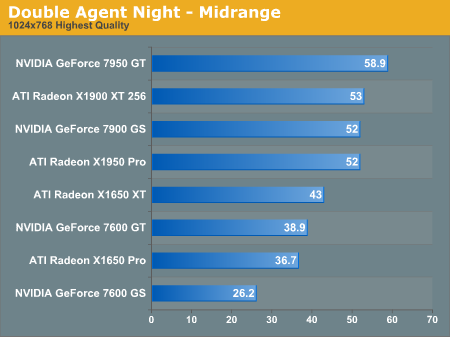
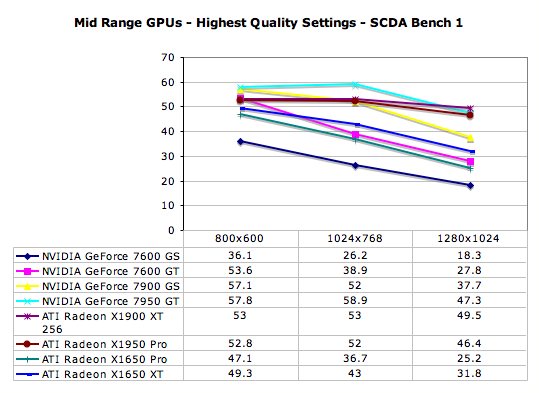


The difference in performance between the X1650 XT and 7600 GT further illustrates the fact that this game runs better on ATI hardware. These two cards are direct competitors in performance and price, and the X1650 XT sees about a 14% increase in performance over the 7600 GT. At around $140 The 7600 GT is a little cheaper than the X1650 XT right now, but we found a Sapphire X1650 XT for about $150 which would be a much better buy if Splinter Cell: Double Agent is your game of choice. The two cards trade blows in other titles, so the final decision will come down to game preference, but we would give the X1650 XT a slight edge overall.
For our medium quality performance tests, we left out the higher end cards from NVIDIA and ATI which obviously didn't need a performance boost at the sacrifice of image quality. Double Agent's graphics suffer with the shadow effects disabled, in some levels more than others, so high-quality settings should be enabled to get the most out of the game if your hardware can handle it. We also found the game looked and played well on some mainstream cards at lower resolutions like 1024x768 with all the effects enabled, so turning down the resolution a little might be a good solution for less powerful hardware. For those that must play the game at higher resolutions, turning off some of the shadow effects as well as trilinear filtering can significantly improve performance.
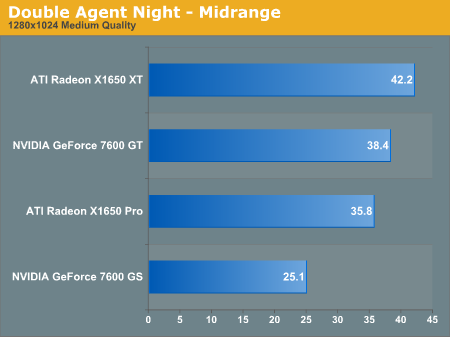
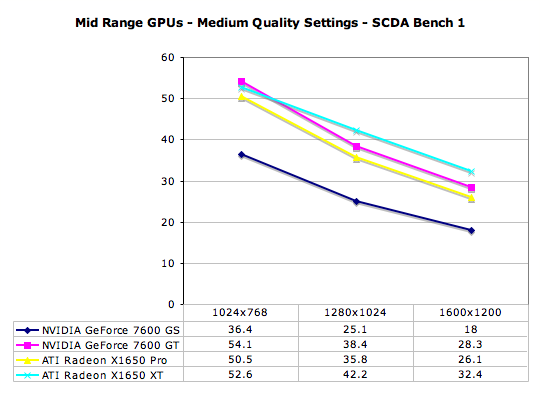
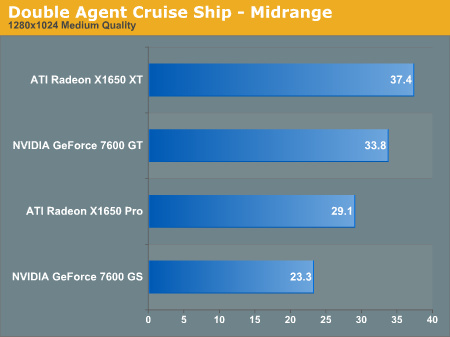
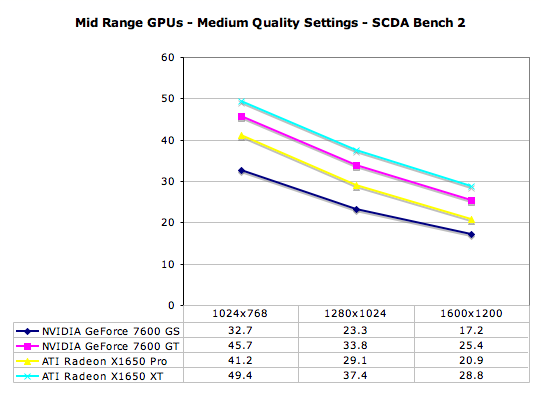
The performance differences we see for the cruise ship benchmark when the shadow/shader effects are disabled are much more dramatic than with the first benchmark. This is because in the particular test we chose, there are lots of shadows created by the bright sun shining down on the whole front deck of the boat. This is very different from the first benchmark which takes place under the cover of night with night vision enabled. Without the high quality soft shadows and high detail shader enabled, there is a marked difference in how the deck looks as Sam slides down the cable. It just looks like the weather has changed from bright and sunny to overcast suddenly, which doesn't take that much away from the actual gameplay.
The midrange or mainstream cards we chose to test were the NVIDIA 7600 GT and 7600 GS, as well as ATI's X1650 XT and X1650 Pro. Since some of these cards had trouble running the game at all the resolutions with high quality enabled (especially with the cruise ship benchmark), we tested these cards on both benchmarks with both the highest quality settings enabled, and again with the lower quality graphics settings (high quality soft shadows, high detail shader, and trilinear filtering set to off).




The difference in performance between the X1650 XT and 7600 GT further illustrates the fact that this game runs better on ATI hardware. These two cards are direct competitors in performance and price, and the X1650 XT sees about a 14% increase in performance over the 7600 GT. At around $140 The 7600 GT is a little cheaper than the X1650 XT right now, but we found a Sapphire X1650 XT for about $150 which would be a much better buy if Splinter Cell: Double Agent is your game of choice. The two cards trade blows in other titles, so the final decision will come down to game preference, but we would give the X1650 XT a slight edge overall.
For our medium quality performance tests, we left out the higher end cards from NVIDIA and ATI which obviously didn't need a performance boost at the sacrifice of image quality. Double Agent's graphics suffer with the shadow effects disabled, in some levels more than others, so high-quality settings should be enabled to get the most out of the game if your hardware can handle it. We also found the game looked and played well on some mainstream cards at lower resolutions like 1024x768 with all the effects enabled, so turning down the resolution a little might be a good solution for less powerful hardware. For those that must play the game at higher resolutions, turning off some of the shadow effects as well as trilinear filtering can significantly improve performance.




The performance differences we see for the cruise ship benchmark when the shadow/shader effects are disabled are much more dramatic than with the first benchmark. This is because in the particular test we chose, there are lots of shadows created by the bright sun shining down on the whole front deck of the boat. This is very different from the first benchmark which takes place under the cover of night with night vision enabled. Without the high quality soft shadows and high detail shader enabled, there is a marked difference in how the deck looks as Sam slides down the cable. It just looks like the weather has changed from bright and sunny to overcast suddenly, which doesn't take that much away from the actual gameplay.










28 Comments
View All Comments
sdedward - Friday, December 8, 2006 - link
Have you ever gotten a recall letter in the mail? Thats basically what it says.
shabby - Friday, December 8, 2006 - link
But every car doesnt have a recall. Today it seems like every game gets patched before it even hits stores.Josh Venning - Friday, December 8, 2006 - link
It is very frustrating when a game is released that seems as unfinished as this. The problem is that unlike with other types of products, it's not very easy to pin down who/what exactly is responsible for the problems. Regardless of this, the consumer is the one who ends up suffering, and that's just unacceptable. Thanks for your comments.Jodiuh - Friday, December 8, 2006 - link
Printing now! Thanks for continuing to provide that button. Quite a few sites have removed it and they wind up not getting their arty's read. My notebook gets hot, so I prefer to read these on paper in a comfy chair, couch, bed, etc. :DSomewhat OT, should I be playing the SC series in order? I played through about 25% of the first one and maybe 10 minutes of Chaos Theory. Are they good enough to play through? Should I just play Double Agent?
Le Québécois - Friday, December 8, 2006 - link
Yes I think playing all the SC series in order would be a good thing since every one of them was(still is) a very good game(if you like the stealth/assassin kind of game of course).The older ones should be pretty cheap to buy IF you manage to find them.
Years after years I am pretty amaze that Ubisoft can come with a pretty good game franchise with so little time between the release of each games.
Jodiuh - Friday, December 8, 2006 - link
Buddy's gonna let me borrow the first one. I'll hit it up after HL2.Josh Venning - Friday, December 8, 2006 - link
I personally only played Chaos Theory and Double Agent, but I found them both to be very enjoyable. I think the storyline of Chaos Theory might have been a little better than Double Agent, especially towards the end, but Double Agent had some more interesting gameplay scenarios. I highly recommend playing them both through though, if you can.Jodiuh - Friday, December 8, 2006 - link
Just got through the article...I guess I'll start w/ a SC game that'll run on my card then, lol. This has to be the worst evidence yet of console porting. Normally, it's the interface that sucks. But DA screams port in a hardware way!! And it makes me hate the consoles even more...